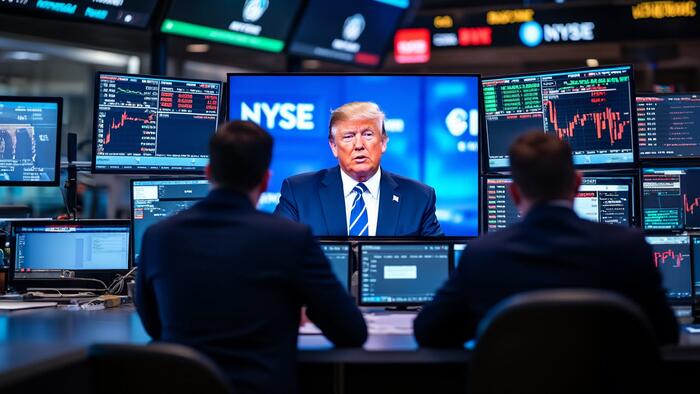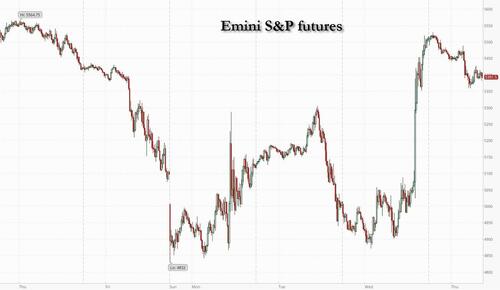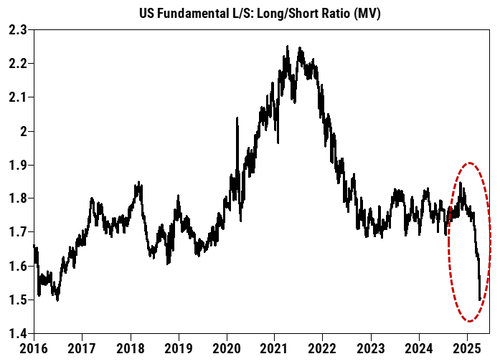


The record (notional) bounce-back in global equity markets, which pushed the S&P higher by nearly $5 trilllion in market cap after Trump delayed plans to implement higher reciprocal tariffs on dozens of trade partners, has started to fizzle a bit. S&P 500 futures are down 1.6% after Wall Street logged its best day since 2008 on Wednesday, while Nasdaq 100 contracts drop 1.9% as the market takes some profits and moves to assess Trump’s updates, following a global relief rally. Premarket Mag7 names are under pressure with much of the group down ~2%. Financials, Healthcare and Semis other notable sectors moving lower. Global markets soared in sympathy with the US rally yesterday: Asian equities posted their biggest jump in more than two years and European stocks staging their strongest rally since March 2020, however while the Stoxx 600 surged over 7% at the open it has since pared its advance to less than 5%, as banks and financial services, this session’s outperformers, trim gains. Treasuries reversed an earlier gain, with US 10-year yields first falling 5 bps to 4.28% before reversing and trading unchanged at 4.33%; there is a 30-year bond auction later today which will be closely watched. The mood shift is also evident in currency markets where haven demand has returned, pushing the Japanese yen and Swiss franc to the top of the G-10 leader board. Spot gold climbs $25 to $3,108/oz. The Bloomberg Dollar Index falls 0.6%. Oil prices decline, with WTI falling nearly 3% to $60.70 a barrel. Bitcoin gains fade as it trades lower around $81,000. The main event on today's calendar is the March CPI which may or may not move markets.
In premarket trading, Tesla and Nvidia led losses across the Mag 7 (Tesla -3.5%, Nvidia -3.2%, Meta -1.4%, Apple -2.8%, Amazon -2.3%, Alphabet -1.5%, Microsoft -1.2%). Consumer and financial firms are declining (Walmart -1.1%, Nike -2%, Lululemon -1.5%; Major US banks: JPMorgan -1.6%, Goldman Sachs -1.7%, Bank of America -1.6%). Chinese e-commerce-linked stocks gain after Trump said he “can’t imagine” increasing tariffs on China any further. Here are some other notable premarket movers:
Yesterday saw the 3rd biggest S&P surge since 1990, as a Trump pivot on trade sparked a historic relief rally; however the rebound may be capped by still-elevated US tariff rates lingering amid damage to investor confidence. With duties on Chinese imports still at 125%, markets will also be watching for signs of whether Beijing plans to raise tariffs further or is signaling a willingness to negotiate.
“The damage has been done. They’ve opened Pandora’s box and they can’t undo what’s been done in one statement,” said Colin Graham, head of multi-asset strategies at Robeco Groep. “We would definitely be a bit more of a seller at this point.”
Other strategists echoed that view. Citigroup advisers are saying “don’t chase this, don’t buy the dip,” the bank’s global wealth head Andy Sieg said in a interview on Bloomberg Television, which however with HF nets are 9 year lows means that as stocks rise, everyone will lag.
Jefferies strategist Mohit Kumar advised allocating away from US markets, and Tiffany Wilding, an economist at PIMCO put the odds of a recession at 50-50, even if the tariff reprieve is extended.
That said, Goldman economists withdrew their US recession forecast (just 77 minutes after making it their base case) following the tariff pause, though analysts still expect policy uncertainty to trigger a sharp economic slowdown later this year. JPMorgan noted that Wednesday’s rally was exacerbated by technical factors and short covering, warning that visibility remained low for investors. Roughly 30 billion shares traded on US exchanges on Wednesday, the most ever.
Meanwhile as Trump escalates his trade war with China, worry is growing that the world’s two largest economies are starting to decouple, as their respective exports to each other face prohibitive duties. “We could again be seeing escalation and de-escalation at the same time, pulling markets in different directions,” wrote Philip Marey, senior US strategist at Rabobank. “Policy uncertainty is likely to remain a drag on business investment, while investors may be seeing US Treasuries in a different light now.”
Companies around the world have already started hitting their own pause button on orders, and the upcoming earnings season is expected to show many firms slashing their guidance for the year. JPMorgan, Morgan Stanley and BlackRock Inc. kick off the run of first-quarter reports on Friday.
Consumer inflation data is due later today, and a Treasury auction of 30-year bonds will be a closely watched for any signs of nervousness around owning US debt.
China’s top leaders have planned to meet on Thursday to discuss additional stimulus, and Beijing is also letting its currency weaken to offset the pressure on the economy. The onshore yuan dropped to levels last seen in 2007 against the dollar on Thursday, before paring the move.
Elsewhere, European and Asian markets rallied as investors caught up to the previous day’s rally on Wall Street. The Stoxx 600 Index was up almost 5%, the biggest gain since 2020, fading an earlier gain of 7%. Banking and mining shares gained the most, while personal care and food beverage stocks were the biggest laggards. Here are the biggest movers on Thursday:
Asia’s stock benchmark jumped the most since November 2022 as US President Donald Trump’s decision to pause higher tariffs on most trading partners sparked a risk-on rally across the region. The MSCI Asia Pacific Index surged as much as 5.6%, following the S&P 500 Index’s best rally since 2008. Taiwanese stocks climbed by a record, leading gains in Asia. Equity gauges in Japan, South Korea and Vietnam were among the other big gainers, while technology and financials were among the top-performing sectors. Stocks in China and Hong Kong still rose, suggesting that investors are counting on more stimulus support from Beijing to shield the economy from tariffs. China’s top leaders are poised to meet Thursday to discuss additional economic stimulus, according to people familiar with the matter. Some investors are also pinning hopes on a possible trade deal with the US after Trump predicted that Chinese authorities would come to the table for negotiations.
The Bloomberg Dollar Spot Index fell 0.8% as US CPI is seen rising 0.1% from February, the smallest monthly gain in eight months, according to the median forecast in a Bloomberg survey of economists. Swiss franc and Japanese yen outperform G-10 peers, as concerns grow that the damage from trade tensions may be more lasting than markets had hoped, fueling fresh anxiety around unpredictability of US policy.
Treasuries gain, with US 10-year yields falling 5 bps to 4.28% ahead of US inflation data and a 30-year bond auction.
Gilts are on a mixed footing with outperformance in the long-end pushing UK 30-year borrowing costs down 15 bps to 5.43% while the front-end trades little changed just below 4%. Bunds yields rise across the curve.
In commodities, oil prices decline, with WTI falling nearly 3% to $60.70 a barrel. Bitcoin gains fade as it trades lower around $81,000.
Looking at today's economic calendar, we get March CPI and weekly jobless claims (8:30am) and federal budget balance (2pm). Fed speaker slate includes Logan (9:30am), Bowman (10am), Schmid (10am), Goolsbee (12pm) and Harker (12pm).
Market Snapshot
Top Overnight news
Trade/Tariffs
A more detailed look at global markets courtesy of Newsquawk
APAC stocks surged following the historic rally on Wall St where the S&P 500 posted its biggest gain since 2008 after US President Trump announced a 90-day pause on reciprocal tariffs to countries aside from China. ASX 200 rallied with the broad-based gains led by outperformance in the tech and energy sectors, while National Australia Bank revised its RBA forecast in which it now sees an oversized 50bps cut in May and the OCR to decline to 2.6% by February next year. Nikkei 225 rocketed to back above the 34,000 level as Japanese exporters cheered the tariff-related relief. Hang Seng and Shanghai Comp joined in on the global rally but with the advances somewhat moderated in the mainland after US President Trump upped the total tariffs on China to 125% from 104% due to China's recent retaliation, while reports also reported that Chinese leaders are to meet on stimulus following the tariff shock.
Top Asian News
European bourses (STOXX 600 +5.4%) opened on a very strong footing, as the region reacted to the latest Trump tariff updates. In terms of price action, indices have been gradually edging off best levels since the European cash open – there is no specific driver for the pressure, but potentially some profit-taking, given the hefty advances. European sectors are entirely in the green, benefiting from the risk tone. Banks outperform today; the sector has been hit in the past few weeks given the yield uncertainty that entered the markets due to the latest Trump tariffs. Basic Resources and Tech are both benefiting from the positive risk tone.
Top European News
FX
Fixed Income
Commodities
Geopolitics
US Event Calendar
DB's Jim Reid concludes the overnight wrap
Market turmoil turned into elation yesterday as Trump announced a 90 day pause on reciprocal tariffs for countries other than China, which marked a sizable backing off from last week’s tariff escalation. That triggered a sharp relief rally as the S&P 500 soared by +9.52% in its best day since October 2008. Other risk assets including credit and commodities also gained, with gold (+3.33%) posting the biggest daily advance since 2023, while 2yr Treasury yields (+18.2bps) saw their largest rise in 6 months.
Starting with the tariff announcement, Trump posted that he would pause for 90 days specific reciprocal tariff rates on non-retaliating countries, with all such countries instead facing a minimum additional tariff rate of 10%. The one exception was China, which Trump said would instead face even higher 125% tariffs, up from 104% the previous day. That came in response to China announcing earlier yesterday higher 84% reciprocal tariffs on US goods, effective today.
Trump suggested that the decision to delay tariffs had been made yesterday morning as people had been “a little bit afraid”. And while Commerce Secretary Lutnick later denied that the move came in response to market pressure, Trump’s comments suggested some sensitivity to the market stress, as he said that “The bond market is very tricky” and “I saw last night where people were getting a little queasy”. Trump noted that he would look at tariff exemptions for certain companies, but also signaled further sectoral tariffs, notably on pharma. As a quick estimate, limiting the reciprocal tariff increase on countries outside of China to a 10% universal rate would take off about 7pp from the near 25% new average US tariff implied by last week’s announcement (from our note last Friday), though this would in part be offset by higher tariffs on China.
With Trump taking at least a temporary off-ramp away from very broad tariff escalation, markets saw a dramatic rebound. The S&P 500 (+9.52%) posted its biggest gain since 2008 with a mere 9 decliners in the entire index, while the NASDAQ (+12.15%) posted its biggest advance since 2001. Other risk assets also benefited, with the sharpest tightening in US HY credit spreads (-27bps to 426bps) since December 2023, and Brent crude oil (+4.23% to $65.48/bbl) posting its biggest gain in six months. The VIX fell by -18.7pts to 33.6.
This morning Asian equity markets are posting their biggest jump in more than two years. Japan’s Nikkei (+8.360%) and and Topix (+8.01%) are leading the way, while the KOSPI (+5.81%) and the S&P/ASX 200 (+4.57%) are also surging. Despite the increase in duties on Chinese goods, Chinese markets are also seeing gains with the Hang Seng (+1.80%) outpacing the CSI (+1.00%) and the Shanghai Composite (+0.93%). And European futures on the DAX (+7.55%) and Stoxx 50 (+7.78%) are soaring in overnight trading, though US futures on both the S&P 500 (-0.72%) and NASDAQ 100 (-1.26%) are trading in the red after yesterday’s dramatic gains.
While yesterday saw a historic rally on Wall Street, this still left the S&P 500 -3.77% below its level prior to the reciprocal tariff announcements on April 2. And other assets have seen less of a recovery, with 10yr Treasury yields +20bps higher and US HY credit spreads +92bps wider. So while there has been understandable relief as evidence of a Trump put reemerged following the extreme market conditions that we highlighted yesterday morning, the genie is still out of the bottle on policy unpredictability. Indeed, a 10% minimum universal tariff represents the largest tariff increase in decades and heightened trade uncertainty is likely to linger, with limited visibility on what kind of deals the US would find acceptable. Perhaps most crucially, we are currently still on course for a disorderly economic decoupling between the world’s two largest economies, with no immediate signs of either US or China backing down.
Prior to tariff pause announcement, market sentiment already saw some improvement yesterday following yesterday's strong 10yr Treasury auction. This saw $39bn of 10-year notes issued at a yield of 4.435%, -3.0 bps below the pre-sale yield, which came amid very strong demand by indirect bidders. This supported a rally in Treasuries, as 10yr yields fell from 4.46% just before the auction to 4.34% by the close (+4.1bps on the day). 30yr yields declined by -2.8bps to 4.74%, despite having briefly touched 5% in overnight trading yesterday. Treasuries are seeing a further rally in Asia trading, with the 10yr yield down -5.3bps.
On the topic of bond market stress, Cleveland Fed President Hammack said yesterday that “The markets look strained, but functioning”. Our own Matt Raskin discussed the conditions under which the Fed might intervene to preserve market functioning in a note yesterday.
By contrast, the risk-on mood drove a sharp sell-off at the front-end of the Treasury curve, with 2yr yields rising +18.2bps to 3.91%. That came as the amount of cuts priced by the December meeting fell by a full -25bs to 77bps. The move also came amid hawkish-leaning Fedspeak, with Minneapolis Fed President Kashkari writing that with tariffs the bar for rate cuts is higher even if facing a weaker economy, echoing Fed Chairman Powell’s more hawkish messages from last Friday. Meanwhile, the minutes of the March Fed meeting showed some participants seeing “difficult tradeoffs if inflation proved to be more persistent while the outlook for growth and employment weakened”.
Earlier on in Europe, equities had seen a sharp decline, with the STOXX 600 and FTSE 100 falling by -3.50% and -2.92% respectively. The market mood had been weighed on by China’s retaliation against US tariffs, as well as yesterday’s announcement that the EU had approved tariffs on €21bn of US goods in retaliation for Trump’s 25% steel and aluminium duties. European bond yields saw mixed moves as 10yr bunds (-3.9bps) rallied, but OATs (+0.2bps) and BTPs (+2.5bps) saw modest sell offs. GIlts underperformed, with the 10yr yield up +16.9bps and the 30yr yield (+23.3bps) rising to 5.58%, its highest since 1998.
In other European news yesterday, Germany’s incoming chancellor Friedrich Merz sealed a deal with the Social Democrats to form the next government. The sooner-than-expected coalition presented their policy roadmap for the next four years, presenting no major fiscal or macro surprises as our German economists note. The coalition treaty has yet to be approved by the parties before it can be formally signed.
Overnight in China, consumer prices fell for the second straight month, down -0.1% y/y in March after a -0.7% fall in February. Producer prices (-2.5% y/y v/s -2.3% expected) fell for the 29th month in a row, notching the largest contraction in five months. Following the data release, the onshore yuan was hovering near multi-decade low, trading at 7.3454 against the dollar, its weakest level since 2007. The latest drop also came after the PBOC weakened the yuan fixing for a sixth straight session.
To the day ahead now, the main release will be the US CPI for March, where our US economists expect a +0.3% core inflation print, albeit in a close call with +0.2%. You can see their full preview and register for the post-release webinar here. Other data release include the US federal budget balance, initial jobless claims, China March CPI and PPI, Japan , Denmark, and Norway March PPI. The US 30yr bond auction is also taking place today.


